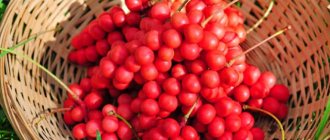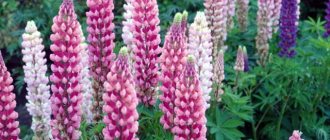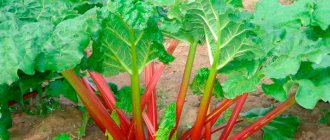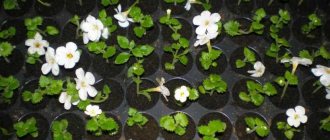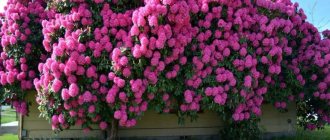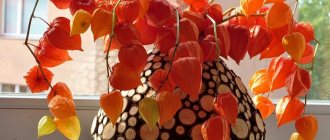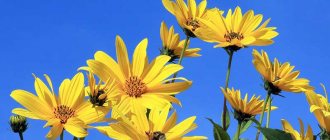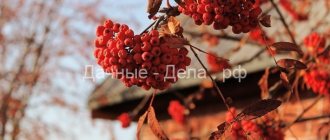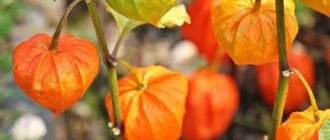Gardeners can boast of a wide variety of different ornamental plants, which they happily grow in their garden plots. Among them there are both perennial and annual plants. Some of them are distinguished by the beauty of their flowers, some by the unusual shape of their leaves. Some of them bloom earlier, some are distinguished by late flowering. Among such diversity, forest plants are also distinguished, which are not inferior in their exoticism and modest natural beauty to other lush and vibrant crops. Clefthoof is just one of these plants, the leaves of which serve a decorative function.
Grass Kopyten: photo
Description of the plant
Coffin is a representative of a perennial evergreen genus of the Kirkazonaceae family.
The height of the plant is no more than 10 cm. The roots of the hoofed grass are branching, creeping, with numerous thin adventitious cord-like roots. The leaves are simple, kidney-shaped, 5-8 cm in diameter, opposite, leathery, dense, round, heart-shaped or triangular in shape, with a solid edge, well-defined veins, on long petioles, between which flower buds are formed. The outline of the leaf looks like a horse's hoof print, which is why it got its name. As a rule, the width of the sheet exceeds the length. The leaves of the coffin are glossy on top, rich green-emerald in color, and covered with pressed small hairs on the underside. The foliage turns dark green during the cold season. With the onset of spring, until summer, the leaves gradually die off, making way for new ones.
The flowers are goblet or bell-shaped, apical, small, no more than 1 cm in diameter, fleshy, bisexual, solitary, axillary, dark red-brown in color with 3-4 hard petals. In most cases, flowers form at the ends of young shoots and are hidden under dense foliage. A distinctive characteristic of the plant is that it is pollinated by ants, with their help the seeds are dispersed. Flowering period April-May. Flower buds are laid in the summer, flowering occurs a year later.
The stem is branched, recumbent, brown, thick, up to 30 cm in length, covered with short appressed hairs.
The fruit is a seed capsule. The seeds are about 3 mm long, with a fleshy white appendage.
Other names for the plant: wine root, vomit root, vomit root, wild pepper, hoof grass, wild ginger, turpentine root, emetic root, fever herb.
When describing the coffin, attention is paid to the presence of the smell and taste of the foliage, reminiscent of hot pepper. Previously, a product (powder) was prepared from the coffin, which was used as an additive to snuff.
Where does the ungulate grow?
Most species grow in warm tropical zones, 13 species can be seen in the temperate zone of North America and Eurasia. On the territory of Russia you can find only 3 types of ungulate: the European species grows in the forest and forest-steppe zone of the central zone of the European part of Russia, Western Siberia, Western Europe; intermediate species - in the Caucasus; Siebold's hoof - in the Far East. Found in isolation in Altai, rarely in the northern regions.
Brief description of the European cleftfoot
European hoofweed (hooffoot) is a perennial herbaceous plant up to 10 cm tall. The rhizome is creeping, branched. The brownish, crawling worm-like stem of the hooffoot hides among the grass and fallen leaves.
At its end grow two light green opposite leaves with long petioles. Between them, near the ground, there is a flower bud. It is laid in the fall and overwinters under the snow, covered with fallen leaves.
The leaves are broad-budded, long-petiolate, entire, dark green above, shiny, matte below, paler, usually remain throughout the winter. The shape of the hoof leaves resembles the mark of a small horse's hoof. Flowering and seed formation occurs in the hoofed grass at the time the ants feed the larvae. The seeds, equipped with a fleshy white appendage, fall to the ground, and then the ants, attracted by the delicacy, begin to take them throughout the forest, dropping them on the way to the anthill. The ants eat only the appendage without touching the seeds.
The flowers of the plant are brownish on the outside, dark purple on the inside, solitary, apical, with two leaves. The perianth is simple, bell-shaped, greenish-purple, tripartite. There are 12 stamens with a ligament elongated into a styloid process. Pistil with a lower ovary, 6 columns, fused at the base into a grooved column, widened at the top with a six-rayed stigma. The fruit is a six-locular capsule with remains of dried perianth at the top. The seeds are grayish-brown, finely wrinkled. It blooms in May, the fruits ripen in June.
The plant has a characteristic pepper smell.
Types and varieties
According to various sources, the genus contains from 60 to 120 species, many of which are grown in the garden as ground cover ornamental plants. They cover the soil under garden trees so tightly that they leave no chance for weeds to grow. All species prefer shade and partial shade, but are able to develop well in illuminated areas. They prefer soil that is moist, loose, and rich in lime; in principle, soil of varied mechanical composition is suitable.
In the natural environment (forest belt), the plant blooms at 5-8 years, in open areas and clearings at 3-4 years.
Tailed ungulate
Tailed ungulate
Homeland - western North America. An evergreen perennial creeping plant that forms a dense soil cover 10-25 cm high. The branched creeping rhizome grows to 8-10 cm per year. The greenness of the leaves is preserved in the cold season. Dense, leathery, green leaf blades on long petioles, 5-10 cm long and 10-15 cm wide, heart-reniform, bluntly rounded or slightly pointed, with a deep and wide heart-shaped base. The underside of the leaf is pubescent, the upper side is drooping along the veins. The flowers are solitary, brown-violet with a white throat, on short stalks. The petals narrow and stretch towards the top, resembling a thin tail in shape. The flowering period occurs later than other species, in late May - early June.
Tailed ungulate
Withstands frosts down to -15...-18 C. Well adapted to the winters of central Russia. If it freezes due to lack of snow, it quickly recovers. A distinctive feature is its rapid growth and tendency to dominate among other ground covers.
Siebold's Hoof
Siebold's Hoof
A type of plant with a short rhizome. Forms neat compact hemispherical bushes 15-20 cm high. The leaves are light green or gray-green, heart-shaped, and disappear in winter.
The flowers are a dark violet-lilac hue, small, reaching up to 1.5 cm in diameter, located at the base of the leaves. They bloom in May. Siebold's hoof is rarely used in culture.
European hoofweed
A perennial evergreen poisonous plant with a branched creeping rhizome and a stem creeping along the ground. It is widely used in folk medicine; in particular, European hoofed grass has proven itself very well in the treatment of alcoholism.
The height of the plant is about 15 cm. The leaves are dense, leathery, heart-shaped, dark green, glossy, no more than 10 cm in diameter.
The flowers are unremarkable, brown-red in color, bell-shaped, axillary, small (no more than 1 cm), hidden in the thick of the foliage, almost close to the ground. Fragrant, the smell is reminiscent of vanilla.
The flowering period is April-May, duration is about 15-20 days.
Self-pollinating plants, seeds ripen in June. The hoofed grass begins to grow under the snow in early spring, and after the snow melts, the leaves unfold. Green foliage lasts about 14-16 months. It can live in one place for more than 30 years.
Description of the herbaceous flower
Clefthoof is a genus containing about 70 species, which is a perennial, herbaceous plant growing up to 10 cm in height, with a branching rhizome.
The leaf of the plant is rounded, but on the side where the petiole approaches it, it is deeply cut. According to the external description, the leaf of the hoofweed is somewhat reminiscent of a horse's hoof print, which is where the name of the plant comes from. There are similarities with the human kidney, as a result of which botanists call it kidney-shaped.
Look at the photo - the leaves of the hoofweed are quite dense, dark green and glossy on top:
They spend the winter alive under the snow. They have a specific smell that is somewhat reminiscent of black pepper. That’s why the coffin is sometimes called “forest pepper.”
The stem of the hoofweed never rises above the surface of the soil; it is always spread out on the ground and is attached to it here and there by roots. At the end there are two leaves on long thin petioles. The leaves are arranged oppositely, one against the other. Between them, at the very end of the stem, in the fall you can see a large bud.
On the outside, the bud is covered with thin translucent covers, under which are the rudiments of two future leaves. They are very small, but are already green in color. These leaves are folded in half. In the center of the bud there is a small ball, similar to a pellet. If you carefully break it, you can see small stamens inside. This means that this is nothing more than a bud. The plant’s amazing foresight: buds are prepared in advance, already in the fall!
As you can see in the photo, in the spring the hoof plant blooms very early, soon after the snow melts:
However, the flowers are hidden in dry fallen leaves and do not appear on the surface for a long time. They have an original dark color, unusual for flowers - brown with a reddish tint. The structure of the flower is also unusual: it has only three petals and 12 stamens. This number is also rare. The flowering of the ungulate usually goes unnoticed by anyone. And when it ends, it can be difficult to say. The flower changes little in appearance after flowering: its petals do not fall off and even retain their shape and color.
By mid-summer, fruits are formed from the flowers of the coffin. In appearance they are almost no different from flowers.
Pay attention to the photo - the fruits of the coffin herb contain brownish shiny seeds the size of millet grains:
The seeds have an interesting feature: each of them is equipped with a peculiar white fleshy appendage. This appendage is a treat for ants. Having found a seed in the forest, the ant immediately drags it to its home. Of course, not all seeds can be delivered to their destination. Many of them are lost along the way in different places of the forest, often far from the mother plant. This is where these seeds germinate. Consequently, hoofweed is one of the myrmecochorous plants.
Planting and propagation
Chopper is a herbaceous plant for open ground. It is propagated by seeds, underground shoots and rooted parts of stems. The fastest and most reliable way to propagate plants is division. Planting is carried out at the end of summer on loose, moderately moist calcareous soil, in a shady or semi-shady area of the garden.
Reproduction
When seeds are planted, they germinate in autumn or spring. In the fall, they are sown in the ground immediately after collecting the seeds, in the spring after 90 days of stratification at a temperature of 0...+5 C. On the surface of the earth, after 1-4 weeks, at a temperature of +15...+18 C, seedlings appear - two leafy bright green cotyledons, a year later the first middle leaf appears, the initial cotyledons die off only in autumn.
They resort to dividing the bush when it is necessary to transplant the hoof from the forest to the garden. Using a knife or shovel, the rooted parts of the stems are separated or the rhizome is cut into sections. Care should be taken to ensure that the plot has a sufficient number of established shoots and roots.
Transfer
Due to its slow growth, the plant rarely needs replanting. The hoofweed is planted immediately in a permanent place. The plant is replanted in the summer or autumn at the 4-5th year of life.
How and where to plant hoofweed
Successful planting of hoofed grass on a site is possible only by selecting a good location for it and following planting technology. If you do not follow the recommendations for planting and care, there is a high risk that the plant will grow unattractively or will soon die.
When choosing a location, you need to take into account the conditions in which the hoof plant grows in nature. It is found exclusively in the shade, so it should be grown only in a shady area, or at least in partial shade. When planted in the sun, the plant completely loses its decorative effect - burns appear on its leaves and they become brown.
In addition to shade, the hoofweed loves humidity. Therefore, it is advisable to plant it on moist, loose soils. The plant makes no demands on the level of soil acidity.
You can grow hoofed grass from seeds or from rooted cuttings. Often the plant is dug up in natural conditions and transplanted into a garden or flower bed, where it grows quickly. Since the seeds are carried by insects, after some time the clumps of the plant can be found at a distance from the mother bush.
Use in folk medicine
European coffin is used for medicinal purposes. Currently, the use of the plant in folk medicine is not as popular as it used to be. European hoofed grass is often used in the treatment of alcohol addiction. Its rhizome is used as an emetic to instill an aversion to alcohol.
Also, medicinal forms from the plant are used to improve digestion, for gastritis, jaundice, stomach and liver diseases, upper respiratory tract diseases, worms, scabies, and menstrual irregularities. Preparations from the leaves of the European ungulate are used for malaria. Lotions, juice and decoctions from hoofweed treat skin lesions.
The chemical composition of the plant European coffin
The study of the chemical composition of the plant has not yet been completed. However, most of the biological and active substances that make up the European hoofweed have already been precisely determined. All parts of the plant contain essential oils, which include such toxic volatile substances as asarone, asaronic aldehyde, eugenol, the alkaloid azarin, etc., as well as tannins (tannins), sugars, starch, bactericidal substances, mineral salts of potassium, calcium , silicalcite, etc.
Pharmacological properties of European ungulate
Preparations based on European hoofweed enhance the functioning of the cardiovascular system, cause constriction of blood vessels, thereby causing an increase in blood pressure.
Medicines containing European hoof have a hemostatic, bronchodilator, anti-inflammatory, sedative, antipyretic, antispasmodic, antisclerotic, wound-healing, choleretic, laxative, antifever, anthelmintic effect, and help improve sputum discharge. If the dosage is exceeded and used incorrectly, it causes vomiting and can cause poisoning.
Contraindications for European ungulate
All parts of the plant contain toxic substances, but most of them are found in the underground part. When using coffin for medicinal purposes, you should be extremely careful, since exceeding the permissible dosage can cause poisoning, which is accompanied by nausea, vomiting, rapid heartbeat, and increased blood pressure. Severe poisoning can be fatal.
Medicinal products based on European hooffoot are contraindicated during pregnancy, as they can cause miscarriage, as well as for people suffering from angina pectoris.
The medicinal properties and contraindications of European coffin should be taken into account when prescribing therapy. Before use, you should consult your doctor about the permissible dose and duration of taking the medicine.
Part used
For medicinal purposes, all parts of the plant - roots, rhizomes, leaves - are used to treat various diseases.
Clefthoof root decoction
It is used to normalize the menstrual cycle with scanty discharge, as a sedative for diseases of the cardiovascular system, and for convulsions in children. Used for fever, as an antipyretic. Lotions based on the medicinal herb of coffin root are used for headaches and eye diseases.
Infusions and decoctions from the rhizome of the coffin are used for stomatitis, silicosis, hysteria, tumors, and also as a hemostatic agent. The powdered roots of the plant are inhaled through the nose for deafness, paralysis with loss of speech. The decoction helps with problems with the digestive system, bladder, liver, and bile ducts.
Decoction of leaves of the European hoofed grass
Used to increase blood pressure and stimulate cardiac activity. A decoction of the leaves of the coffin is used to wash purulent wounds and for various skin diseases.
The coffin is brewed with boiling water in a thermos for 2-3 hours, then filtered and consumed 1-2 tbsp. l. three times a day.
Where to look for European hoofweed
The distribution areas of the coffin plant are very wide - almost the entire European territory of Russia, the Caucasus, Ukraine, Western Siberia.
It can often be found under the shade of trees and shrubs of broad-leaved and mixed forests with grassy undergrowth, in damp places on fertile soil. In the natural environment, growing, plants form dense thickets - patches.
Compound
Due to its composition, rich in valuable substances, the raw material of the cleftfoot plant is used for the manufacture of pharmaceuticals in many European countries (Poland, Sweden, Germany, the Netherlands). The plant includes the following elements and compounds of medicinal interest:
- tannins, bitter substances, glycosides;
- diazoron, asarone, bornyl acetate, 1-pinene;
- asaryldehyde;
- methyl eugenol, azarin alkaloid, eugenol;
- tannins, bactericidal substances;
- eugenol, kaempferol;
- essential oils;
- mineral salts of calcium, potassium, quercetin;
- silicalcite, resins, starch, mucus, sugar;
- coumarin, flavonoids;
- organic acids.
Beneficial features
Cardiac glycosides, kirkazonic acids, tannins (resinous and tannins), flavonoids provide choleretic and diuretic properties, adrenaline-like, emetic and laxative effects, antipyretic and sedative effects of the drug. Galenic components from rhizomes are used as an expectorant, diuretic, and emetic. The plant has anti-inflammatory, hemostatic, bronchodilator, anthelmintic, anti-sclerotic, lactic and wound-healing effects.
An infusion of leaves is used for diseases of the stomach, kidneys and liver. A decoction of them is drunk for heart disease, alcohol addiction, mushroom poisoning, emotional instability, headaches, as a diuretic, and for jaundice. A decoction of the roots and rhizomes of the plant is used as a diuretic for kidney diseases. A decoction of grape syrup enhances potency.
Dried and ground to a powder, the roots and rhizomes of the hoof are used to treat the common cold. The effect is achieved due to the bactericidal substances contained in the plant. It is recommended to apply fresh and pre-crushed leaves of the coffin to abscesses, and a tincture of the leaves in vinegar can be used to wipe areas of the skin affected by scabies. Rubbing with a decoction helps with infectious eye diseases. Essential oils of the plant have a pleasant smell, so their use after the necessary processing is permissible in perfumery.
Application
The pharmaceutical market presents a good selection of herbal medicines, which include raw materials from herbs, which are widely used in domestic and foreign medicine. Coffin is one of the plants officially recognized by pharmaceuticals. Herbalists and traditional medicine healers use European hooffoot for alcoholism, but in addition, the plant can be used in the treatment of the following diseases:
- male infertility, loss of potency, decreased sperm count;
- infection with round or flatworms, helminths, and other parasites;
- in dermatology: eczema, peeling of the skin - an ointment based on the root of the coffin is used;
- lung cancer, high blood pressure;
- cardiac edema, arrhythmia;
- oligomenorrhea;
- jaundice, asthma, cough;
- dropsy of the brain, malaria;
- pneumonia, purulent pneumonia;
- cholelithiasis;
- neurotic joint pain, arthritis;
- migraine, insomnia.
In pharmacies you can find dried roots and herbs; blyakotnik is included in some drugs, for example, drops for alcoholism or the herbal mixture “Stopal”. A tincture from the leaves of the plant is part of the “Akofit” remedy, used for neuritis and radiculitis. It is advisable to use the product under the supervision of a doctor and with permission, because the plant is very poisonous. Uncontrolled use can lead to severe poisoning. It is recommended to strictly adhere to the dosage and not exceed it.
What is the medicinal coffin root used for: recipes
The plant has a wide range of medicinal effects. To prepare various medical products, crushed, dried raw materials from the underground part of the coffin and leaves are used. Using infusions, decoctions, lotions, tinctures, ointments, and powders from the plant, you can improve the course of many diseases, as well as the condition of the body's vital systems. But one of the main advantages of the plant is that the root is used for anti-drunkenness, added to alcoholic drinks and food, to develop a persistent reflex of aversion to alcohol.
European hoofweed from high temperature
Prepare a decoction of 0.5 tbsp. l. crushed dried roots, which are poured with a glass of water, simmered over low heat for 5-10 minutes, cooled, and filtered. Add 1 tsp to a glass of warm milk. honey, butter and herbal infusion, mix. Drink 1/3 cup at a time three times a day. The product has proven itself well against colds and infectious diseases to normalize body temperature. Thanks to this property, one of the plant names sounds like fever grass.
For scabies
To relieve itching and get rid of scabies mites, prepare juice from the leaves of the coffin. Fresh leaves are crushed and the juice is squeezed out of them. The resulting medicinal liquid is rubbed onto the affected area. Apply coffin for scabies once a day for 3-4 days.
Hoof for intestinal diseases
Prepare a decoction of hoofed grass in milk: 1 tbsp. l. crushed dry root pour 1 tbsp. milk, after boiling, cook for 5-10 minutes over low heat. Remove from heat and strain after cooling. Take 1 tsp. twice a day until the condition improves in case of poisoning, colitis, diarrhea.
The use of hooves for alcoholism
The main principle of treating alcohol addiction with a hoof is to use the medicine with the subsequent development of an aversion to alcoholic beverages.
Fresh raw materials have the best healing effect. European hoof for alcoholism is used in cases where an alcohol dependent person does not want to fight the addiction on his own. If there is no trust in medications and there is fear of their side effects, then in these situations they resort to unconventional methods of treatment. Clefthoof grass can help with this.
You should not expect that a one-time dose of a medicinal herb will help. The course of treatment is individual and depends on the degree of addiction to alcohol, the speed of instilling the aversion reflex to alcohol.
In most cases, hooves for alcoholism are used when a person does not want to stop drinking alcohol on his own. To do this, prepare a decoction: 1 tbsp. l. dried or fresh raw materials (root), pour one glass of water, bring to a boil over low heat. Boil for up to 10 minutes. The broth is infused for 40-60 minutes, then filtered, cooled, and stored in the refrigerator. The resulting liquid is added to the food or drink of a person dependent on alcoholism, 2 tbsp. l. for every meal. Since severely alcohol dependent people drink alcoholic beverages during meals, they will experience nausea and vomiting at this point. Also, a decoction of the herb (1 tablespoon) is added directly to an alcoholic drink, after drinking which, after 15-20 minutes, dizziness, nausea and vomiting will begin. In most cases, it is enough to use the decoction 4-6 times to develop a persistent aversion to drinking alcohol.
When a person realizes his “sad” situation and wants to get rid of the addiction, but cannot find the strength to overcome the addiction, he is informed that in order to solve his “problem” he will have to drink an infusion of herbs, which will help cause an aversion to the desire to drink. The patient is offered a glass of alcohol, a decoction is added to it, and after drinking it, vomiting begins. The alcoholic is told that such a reaction occurs only in addicts. To confirm your words, add a similar liquid, prepared in advance, similar in consistency and color to a decoction (this can be tea, juice), into a glass of your opponent’s vodka. The opponent drinks and nothing bad happens to him, like vomiting. This technique acts on the subconscious of the addict, creating a desire to quit drinking and erase the stigma of being an alcoholic.
The point of therapy is to develop a gag reflex when drinking alcohol and get rid of mental dependence. In the first days, the reflex is created under the influence of the ungulate; after stopping the course of treatment, a conditioned reflex is created to take alcohol-containing drinks in the form of vomiting. A person develops a pronounced aversion to any type of alcoholic beverages.
Herb hoofweed for headaches
Prepare the infusion: 1 tbsp. l. crushed dried roots of the plant are poured with a glass of water, boiled for 15-20 minutes over low heat, kept for another 40-60 minutes. Cool to room temperature, filter the solution. A cotton cloth is soaked in the infusion and applied to the forehead for 15-20 minutes. The procedure is carried out 2 times a day.
Hoof for ulcers and wounds
Prepare an ointment for rubbing. To do this, powdered dry roots (1 tbsp) are mixed with 50 g. Vaseline, sea buckthorn, cedar oil or badger fat. The drug is applied to the affected areas 2 times a day until recovery. This procedure helps with poor healing of wounds and ulcers, helps diabetics and people suffering from thrombophlebitis.
Compresses made from fresh plant leaves help against skin ailments. They are washed, crushed, and fixed to the affected area with gauze for 40-60 minutes. The procedure is carried out twice a day until the skin lesion disappears.
Diseases and pests
The leaves of the hoofweed contain essential substances that repel most pests. Therefore, infection of this ornamental crop with parasites is a rare occurrence only if it grows in a contaminated area, among infected plants. However, hoofweed is one of those rare plants that are pollinated by ants. As a result, it attracts these insects to the site, and they pose a threat to many other crops and are carriers of aphids and diseases. Therefore, quite often gardeners have to fight ants by destroying anthills and using insecticides.
Also, slugs and snails love to eat the succulent leaves of the hoofed grass. Special traps or sprinkling the soil with crushed eggshells and pine needles will help drive them out.
Harvesting coffin
The leaves and rhizomes of the plant are used in folk medicine. The leaves are collected in April-May during the flowering period. Many herbalists claim that the leaves can be collected throughout the summer. The rhizome is dug up in the fall (September-October) or spring. The roots are washed from the ground in cold water, cut into pieces, dried in a warm, dark, well-ventilated place or in dryers/ovens at a temperature of +30...+35 C. The shelf life of dried raw materials is no more than 3 years. Store raw materials in glass jars with dark glass or in wooden boxes.
Care measures
In addition to being decorative, hoofed grass has another significant advantage - it requires almost no care. It is worth watering only during periods of prolonged drought. Moisten with warm, settled water, being careful not to get it on the leaves, so as not to provoke burns and the development of rot. The area must be periodically cleared of weeds and loosened.
It is not necessary to fertilize the hoof. Once a year, organic fertilizers can be applied to the bushes.
Most types of hoofed grass are winter-hardy, so they do not need shelter for the winter. Plants winter well under the cover of snow. Only representatives of the brilliant, Japanese and three-pistil species should be covered. It is worth laying a layer of coniferous spruce branches and dry fallen leaves on the bushes.
Use in landscape design
When decorating flower beds, hoofed grass perfectly complements ensembles with ferns, roses, white flowers, and woodlands. In most cases, in landscape design, hoofweed is used as a ground cover plant. Serves as an excellent backdrop for a harmonious combination of various garden compositions, both in the shade and in light areas of the garden. Due to the characteristic feature of leaving the green mass for the winter, it perfectly decorates spring meadows next to snowdrops and lilies of the valley. Due to its compact, dense and miniature appearance, hoofweed is often used in the design of not only flower beds, but also borders, rockeries, and rock gardens.
Clefthoof: the use of herbs
Since in the wild the Hoofweed forms the lowest tier of forests, both coniferous and deciduous, and mixed, and is a carpet of leaves, growing on bare areas of the ground, the Hooffeed feels good in dark places deprived of sunlight. This is what landscape designers use when creating various compositions.
The main decorative function of the Chopper is performed by the leaves, which have a glossy surface and look great, filling the empty space under the crown of large trees and bushes, and also landscaping areas of the ground that do not have favorable conditions for other plants. Chopper gets along with all types of crops, both coniferous and deciduous.
Chopper is planted when decorating flower beds and borders, as well as rockeries, which are built in dark places, protected from sunlight. This plant looks great among the stones in the rock garden.
The ungulate goes well with forest plants that are grown in the same conditions. These are, for example, fern, lily of the valley and others. In addition to joint compositions, this plant is cultivated in hanging pots as a free-standing indoor plant. The crops do not have great growth vigor, so they do not need to be replanted often. In summer you can take it out into the loggias, onto the balcony, and also outside.
Grass Kopyten: photo
